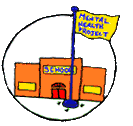November
| To download a copy of this material in pdf format, click here. |
Responding to Referrals in Ways that Can "Stem the Tide"
In previous months, a supportive school has taken steps to welcome and provide social supports, to ensure that students have made a good adjustment to school, and to address initial adjustment problems as they arise. (See the ideas for September and October and follow-up as needed.)
NOW COME THE REFERRALS FOR STUDENTS WHO ARE MANIFESTING BEHAVIOR, LEARNING, AND EMOTIONAL PROBLEMS.
|
|
The key here is for the school team that processes referrals to do three things as they review each student:
- Determine the best course of action for helping the student
- Analyze the problem with a view to ways the classroom and school might change in order to minimize the need for similar referrals in the future
- Take steps to assist in implementing classroom and school changes that can
prevent problems.
Student support staff need to play a major role in such staff development.
Staff Development Focus #1
|
Referral systems need to be designed in ways that stress the analysis of why problems are arising and not just to assess and funnel youngsters to services. And when services are needed, the referral must be designed as a transition intervention to ensure necessary services are appropriately accessed. |
|
The following is a staff development tool for improving the system. Highlighted below are matters to be considered as a school develops its systems for problem identification, triage, referral, and management of care. Problem identification
Triage processing
Clients directed to resources or for further problem analysis and recommendations
Interventions to ensure recommendations and referrals are pursued appropriately
Also, specifically designed as an aid for staff development is the Center's Quick Training Aid on – Case Management in the School Context. |
Staff Development Focus #2
|
It is particularly important to address the reality that a few months into a school year positive motivational influences arising from the newness of the year (novelty, the "honeymoon" period, etc.) will have subsided. Many behavior, learning, and emotional problems arise at this time and could be countered by staff strategies designed to produce "motivational renewal." For staff development to improve understanding of the motivational bases for many behavior, learning, and emotional problems and what to do about them, you can use the following Center resources:
|
|
To help another, it is of great value and in many instances essential to know what the other is thinking and feeling. The most direct way to find this out is for the person to tell you. But, individuals probably won't tell you such things unless they think you will listen carefully. And the way to convince them of this is to listen carefully.
I. Creating the Context for Dialogues
|
A dramatic example comes from a district that found it had a significant increase in teen pregnancies among middle schoolers. Analyses traced the problem to too long a period of unsupervised time from when the school day ended until parents were home from work. To address the problem, the district moved the start of middle school later in the morning so the school day would end later, and with less time to fill, it was feasible to provide more after-school recreational opportunities. The number of teen pregnancies dropped. |
For more materials on these topics, go to the Center Website and use the Quick Find Search to explore the following (among others) topics:
- Case and Care Management
- Motivation
- Enabling Component
- Classroom-focused Enabling
- Environments that Support Learning
- Classroom Management
- School Avoidance
- Dropout Prevention
- Transition Programs/Grade Articulation/Welcome
| To download a copy of this material in pdf format, click here. |
|
Center for Mental Health in Schools WebMaster: Perry Nelson (smhp@ucla.edu) |
 |